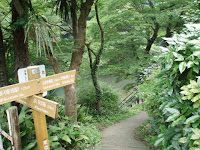Leaving JR Sawai Station, walk down a steep slope until you reach Ome Kaido Street. Cross this street at the crosswalk and go eastward for about 50 meters, and, on your right, you will find the slope that leads to Sawanoien, a rest station where you can enjoy sake and shopping. Actually, you can see the garden of these facilities below on your right. You will find the entrance of Sawanoien on your right at the bottom of this slope. The statue named Sawanosuke was beckoning us to enter Sawanoien, but we had decided go for a walk and have lunch at another place. See you later today, Sawanosuke! Just a little beyond the entrance, a directing post will tell you which way to go. From this point, we walked toward the upper stream along the riverside walkway.


From the walkway, you can overlook the cool limpid Tama River. There were those enjoying their kayaks in the river. The water looked cool. There are also sweetfish anglers. The method they were using for fishing was "Tomozuri," which used live decoys.


Probably, you need a straw hat or parasol in such a day of strong sunlight. I think it is rakish walking the pathway flanked by hydrangeas with wearing yukata kimono. This day, I was wearing yukata kimono with dragon patterns.


There was an unattended vegetable shop. I guess these long vegetables in the picture below were butterbur stems, and these red things were probably tomatoes. They were also selling pickled ume, which is a specialty of Ome City. The dog-like image depicted on the talisman affixed on the pillar seemed to have been received from the Mitake Shrine (FYI: read Takigi Kagura of the Mitake Shrine).

My word! I didn't expect to find a cafe on this walkway. A lady at the cafe called to us to drop in for some drink, saying "We have good Japanese-style rooms that will suit your yukata." Unfortunately, we had already decided to eat lunch soon at another restaurant. However, she let us see the inside of the cafe.


It must be nice to enjoy coffee in river breeze at a table in the pavilion overlooking the Tama River or chatting away with friends in an old-fashioned room being surrounded by antique furniture. I must remember the place of this cafe, "Tsuinkuru," for the next time.


There was a restaurant and inn, "Yuzu no Sato Shosenkaku," next to this cafe. We had lunch here after enjoying a hot citron bath they were offering.


The lunch was a Japanese style kaiseki set. Being named "Yuzu no Sato" (citron village), the restaurant served various foods using citron as an ingredient, including after-bathing citron tea, citron wine as an aperitif, and other dishes.


After we had had relaxing lunch, Shosenkaku kindly offered us a ride and drove us to Sawanoien, which is run by Ozawa Syuzou. At the sake tasting corner in Sawanoien, you can taste various types of Sawanoi sake at quite reasonable prices.


Memo: You can start walking from JR Mitake Station (next station to Sawai). In that case, the walkway you will walk along will be about twice as long as the way we take this time (but it is not very long, and you can walk through all the way in 20 to 30 minutes).
(Map)
より大きな地図で 酒蔵のある散歩道(4) を表示
Today's Sake
Junmaiginjo Nama Genshu Ryobo-Reirou (Ishikawa Brewery)
Being modest in aroma but having rich taste of rice, this sake has a favorable impression. I perceive the acidity of some fruit in the aftertaste.
Rice used: Gohyakumangoku
Seimaibuai: 55%
Alcohol: 16 - 17%

No comments:
Post a Comment